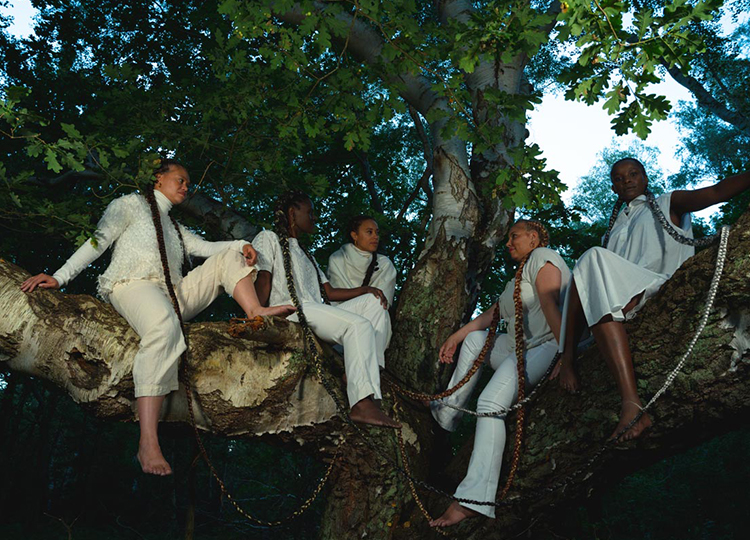Artist Mónica de Miranda fuses fact and fiction in her new commission The Island to explore a long trajectory of black presences in Portugal by bringing together intertwined narratives – drawing on African liberation movements, migratory experiences, and identity formations through a black feminist lens.
The series was created for Autograph’s commissioning project Amplify — Stranger in the Village: Afro European Matters. Here, art historian and writer Taous R. Dahmani considers the allegorical value of the mirror in the work, as both a reflection on histories and as a metaphorical construct to consider speculative futures.
"I will be free because I fight"
— Mónica de Miranda, The Island (2021)
As in other memorable tales, Mónica de Miranda’s visual storytelling in The Island (A Ilha) revolves around a central motif: the mirror or looking glass. Concrete (via the made object) or natural (by way of reflection in water), mirrors appear again and again in The Island. Revealing invisible truths and deepest desires, the looking glass in de Miranda’s work becomes an intricate polyphonic knot: it both folds and unfolds a multilayered narrative. Through a film and a series of photographs, de Miranda uses the mirror as a structuring device allowing her to probe, in all their complexity and multiplicity, ideas of identity (self and otherness) and history (past, present and potential future). While the mirror, as a motif, is a well-established trope in art history, with this project de Miranda undertakes a reappropriation of the looking glass as a powerful contemporary metaphorical form. Indeed, de Miranda ‘reclaims the mirror’ and updates its symbolic values in light of her decolonial, feminist and ecological stances.

"Revealing invisible truths and deepest desires, the looking glass in de Miranda’s work becomes an intricate polyphonic knot: it both folds and unfolds a multilayered narrative."

Throughout the centuries, literature and visual culture have often used the mirror as an allegorical tool. When Lewis Carroll gave Alice a mirror in 1871, it was to offer her the possibility of entering a world of fantasy.¹ Then, more than 60 years later, in Virginia Woolf’s The Lady in the Looking Glass (1929), a woman is described facing a mirror: ‘She stood naked in that pitiless light. And there was nothing. Isabella was perfectly empty.’² If Carroll used the mirror as a device for his main character’s transition into womanhood, and if Woolf deployed it as a means to reflect on ideas of loneliness and emptiness, a century later I would suggest that de Miranda positions her model in front of a mirror not to invite her to escape her condition, but to imagine all that is possible, to visualise a different past and a distinct future: ‘I breathe, I sigh, I exhale the warmth of a future, the forgetfulness of the part, I inhale the present, the place from where I never left and I forgot that here I review myself in you, in wait of the emptiness that transcends and casts my reflection […] the reflection where I see and mirror myself’ (The Island, film, 34′10″ – 34′59″).
In The Island, de Miranda reinvents the parabolic charge of the mirror as an object of empowerment: questions are both asked and answered by the same purposeful main character, a forceful black woman. In many ways inspired by French psychoanalyst Jacques Lacan, for the artist, the mirror is not only used to externalise parts of a woman’s psyche but also to envision women’s wishes and their tenacity. As such, the externalisation takes very concrete shapes. In the four photographs entitled Mirror Me, a woman faces a mirror wearing – in succession – a captain’s cap, a cowboy hat and a horse-riding helmet. Through the duality created by the looking glass, de Miranda evokes gendered ideas of power, function and influence, and adopts the mirror as an apparatus for potentiality: conceptualising alternatives and turning desires for equality into actual images. The mirror as a ‘manifesting device’ can also be found in the feminist poetry of Sylvia Plath, Adrienne Rich and Audre Lorde, as it can in the work of African American artist Carrie Mae Weems, who regularly uses a mirror as a compositional instrument to shape her photographs and self-portraits in particular, such as in the series Mirror, Mirror (1987–8) or Not Manet’s Type (1997). In Weems’s work the mirror suggests the figure’s fully-owned agency and invites the viewer into a considerate contemplation. In line with this thinking, de Miranda’s work endorses the mirroring device as an externalisation of black women’s manifold views and visions. Although the evident, yet strange, precept of mirrors is the revelation of one's reflected image, in Mirror Me the optics are imaginary.

"Refusing to look the other way, spurning history as told by dominant forces, the mirror becomes an epitome of agency."

For de Miranda, the looking glass is a means by which to formulate desirable futures, but it is also used as a mechanism for revisiting history. In the film, which expands on the narrative of the photographic still images, the mirror as an artefact occurs at least twice (6′16″ and 34′): firstly, when the main protagonist, lying on her bed, is seen through a wall mirror – perhaps insinuating a form of reverie about times to come – and secondly when she is seated opposite the mirror, musing about the past – conjuring intricate historical narratives. In these two scenes, as in others, de Miranda weaves together individual destinies with the impact of traumatic episodes in our shared history.
In The Island, the ‘mirroring effect’ is also introduced by the surface of the water. Streams, rivers or the sea, and the images that form on them by way of reflection, are used to summon history and awaken its forbidden chapters. In Whistle for the Wind de Miranda’s main character is seen overlooking a vast expanse of water as if searching for answers about a troubled past. Indeed, de Miranda’s fable takes place on an island known for its link with Portuguese colonial history. This very real island, a few kilometres away from Lisbon, is also known for its seventeenth- and eighteenth-century folk tales, in which the enclave was disparagingly named ‘a Ilha dos Pretos’ (the Island of Black People). As such, the island becomes a direct geographical reference to Portugal’s violent colonial past, where mirrors – crafted objects or natural phenomena – channel the uncovering and acknowledgment of generations of enslaved people, as well as recreate and reaffirm their legacy. In another context, but appropriate here, the late scholar bell hooks explained how ‘the politics of slavery, of racialised power relations, were such that the slaves were denied the right to gaze’³, linking here the island’s history to acts of vision, the performance of looking and the centrality of reflection, while turning the mirror into a powerful political tool.
De Miranda not only ‘reclaims the mirror’ as an apparatus but also subverts its meaning by placing a black woman in front of it. Refusing to look the other way, spurning history as told by dominant forces, the mirror becomes an epitome of agency. ‘There is power in looking’, as bell hooks stated – indeed, for Mónica de Miranda the look in the rebellious mirror is a strategy, crafted for a fighter to gaze at.⁴
______
¹ Lewis Carroll, Through the Looking-Glass, and What Alice Found There, 1871.
² Virginia Woolf, The Lady in the Looking Glass, 1929, p. 19.
³ bell hooks, ‘The Oppositional Gaze. Black Female Spectators’, Black Looks: Race and Representation, South End Press, Boston, 1992, p. 115.
⁴ Ibid.

is a French, British and Algerian art historian, writer and curator specialising in photography. Her academic research focuses on the photographic representation of struggles and the struggle for photographic representations.
Her projects mainly involve the links between photography and politics — such as the visual culture of protests, migratory narratives and intersectional feminist discourses. She has published in various journals and art magazines, and regularly gives papers in academic conferences, and holds public ‘in-conversations’ with photographers. She works between Marseille and London. Dahmani is also editor and content advisor at The Eyes, a trustee of the Photo Oxford Festival and serves on the editorial board of MAI: Visual Culture and Feminism. She is the 2022 Louis Roederer Discovery Award curator at Rencontres d’Arles.

Autograph's commissioning project considering contemporary Afrodiasporic experiences in Europe, supported by the Art Fund.
Read more
Banner image: Mónica de Miranda, Mirror Me, [detail], from The Island, 2021. Commissioned by Autograph. Supported by Art Fund.
Images on page: 1-4) Works from Mónica de Miranda's commission The Island, 2021, © and courtesy the artist, commissioned by Autograph. 5) Taous Dahmani. 6) Jeannette Ehlers We're Magic. We're Real. #5 [detail] from Sunset to Sunrise, 2021. © and courtesy the artist, commissioned by Autograph.
Discover more: 1) Mónica de Miranda, Double Force [detail], from The Island, 2021. Commissioned by Autograph. Supported by Art Fund. 2) Mónica de Miranda: The Island exhibition at Autograph. 24 June - 22 October 2022. Curated by Renée Mussai and Mark Sealy. Photograph by Kate Elliot. 3) Mónica de Miranda, Tide, [detail] from The Island, 2021.
Autograph is a space to see things differently. Since 1988, we have championed photography that explores issues of race, identity, representation, human rights and social justice, sharing how photographs reflect lived experiences and shape our understanding of ourselves and others.